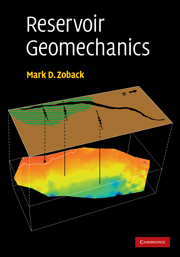Book contents
- Frontmatter
- Contents
- Preface
- PART I BASIC PRINCIPLES
- 1 The tectonic stress field
- 2 Pore pressure at depth in sedimentary basins
- 3 Basic constitutive laws
- 4 Rock failure in compression, tension and shear
- 5 Faults and fractures at depth
- PART II MEASURING STRESS ORIENTATION AND MAGNITUDE
- PART III APPLICATIONS
- References
- Index
- Plate section
3 - Basic constitutive laws
Published online by Cambridge University Press: 10 December 2009
- Frontmatter
- Contents
- Preface
- PART I BASIC PRINCIPLES
- 1 The tectonic stress field
- 2 Pore pressure at depth in sedimentary basins
- 3 Basic constitutive laws
- 4 Rock failure in compression, tension and shear
- 5 Faults and fractures at depth
- PART II MEASURING STRESS ORIENTATION AND MAGNITUDE
- PART III APPLICATIONS
- References
- Index
- Plate section
Summary
In this chapter I briefly review a number of the constitutive laws governing rock deformation. Fundamentally, a constitutive law describes the deformation of a rock in response to an applied stress (or vice versa). Because of the breadth of this subject, the material below is restricted to covering key principles that will be referred to later in the text.
One unconventional topic discussed at some length at the end of this chapter is the viscous compaction of uncemented sands. As explained below, the presence of water or oil in the pores of a rock will result in time-dependent deformation of any porous elastic (poroelastic) solid. The topic I discuss below is the viscous deformation of dry uncemented sands. In other words, in addition to the poroelastic deformation, there is also time-dependent deformation of the dry matrix. There are two main reasons for this. First, many oil and gas reservoirs in the world occur in such formations. Thus, it is important to accurately predict: (i) how they will compact with depletion (especially as related to compaction drive); (i) what the effects of compaction will be on reservoir properties (such as permeability); and (iii) what the effects will be on the surrounding formations (such as surface subsidence and induced faulting). The basic principles of viscous compaction of uncemented sands are outlined in this chapter, whereas the compaction of reservoirs composed of such materials is addressed in more detail in Chapter 12.
- Type
- Chapter
- Information
- Reservoir Geomechanics , pp. 56 - 83Publisher: Cambridge University PressPrint publication year: 2007

